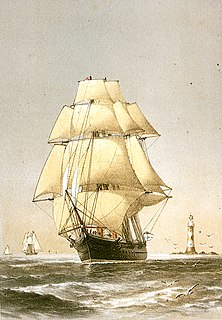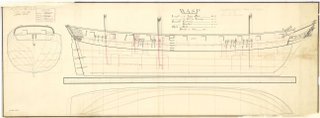
HMS Intrepid (L11) was one of two Fearless-class amphibious warfare ships of the Royal Navy. A landing platform dock (LPD), she served from 1967 until 1999. Based in HM Naval Base, Devonport, Plymouth, Devon and HM Naval Base Portsmouth, she saw service around the world over her 32-year life.

HMS Invincible was a Royal Navy Audacious-class ironclad battleship. She was built at the Napier shipyard and completed in 1870. Completed just 10 years after HMS Warrior, she still carried sails as well as a steam engine.

HMS Caroline is a decommissioned C-class light cruiser of the Royal Navy that saw combat service in the First World War and served as an administrative centre in the Second World War. Caroline was launched and commissioned in 1914. At the time of her decommissioning in 2011 she was the second-oldest ship in Royal Navy service, after HMS Victory. She served as a static headquarters and training ship for the Royal Naval Reserve, based in Alexandra Dock, Belfast, Northern Ireland, for the later stages of her career. She was converted into a museum ship. From October 2016 she underwent inspection and repairs to her hull at Harland and Wolff and opened to the public on 1 July 2017 at Alexandra Dock in the Titanic Quarter in Belfast.

HMS Active was a Volage-class corvette built for the Royal Navy in the late 1860s. Launched in 1869, she entered service in 1873, and was the Commodore's ship on the Cape of Good Hope and West Africa Station. Her crew served ashore in both the Third Anglo-Ashanti and Zulu Wars. From 1885 to 1898, the ship was the flagship of the Training Squadron. Active was sold for scrap in 1906.

HMS Tamar was a Royal Navy troopship built by the Samuda Brothers at Cubitt Town, London, and launched in Britain in 1863. She served as a supply ship from 1897 to 1941, and gave her name to the shore station HMS Tamar in Hong Kong.

Admiral of the Fleet The Honourable Sir Hedworth Meux was a Royal Navy officer. As a junior officer he was present at the bombardment of Alexandria during the Anglo-Egyptian War.
Four ships and a shore establishment of the Royal Navy have borne the name HMS Boadicea after Boadicea, queen of the Iceni in Roman Britain, whilst another ship was planned but never completed:

HMS Opal was an Admiralty M-class destroyer of the Royal Navy. She served in the First World War following her construction at Sunderland in 1915. Attached to the 12th Destroyer Flotilla based with the Grand Fleet at Scapa Flow, Opal had an eventful short life, which ended in shipwreck after two and a half years of service.

HMS Boadicea was a B-class destroyer built for the Royal Navy (RN) around 1930. Initially assigned to the Mediterranean Fleet, she was transferred to the Home Fleet in 1936. Before her departure, the ship evacuated civilians from Spain during the beginning of the Spanish Civil War of 1936–1939. Boadicea later spent considerable time in Spanish waters, enforcing the arms blockade imposed by Britain and France on both sides of the conflict. During World War II, the ship spent the bulk of the war on convoy escort duty in British waters and participated in the Battle of the Atlantic, Operation Torch, the Russian Convoys, and in the Normandy landings. Badly damaged by German dive bombers in 1940, she was sunk almost exactly four years later by German aircraft.

Admiral of the Fleet Sir Frederick William Richards, was a Royal Navy officer. He commanded a paddle-sloop during the Second Opium War in 1860 and, as senior officer on the Cape of Good Hope and West Coast of Africa Station, he landed on the coast of South Africa with a small naval brigade which he led at the Battle of Gingindlovu and the Siege of Eshowe in April 1879 during the Anglo–Zulu War. He took part in the Battle of Laing's Nek in January 1881 during the First Boer War and, as Commander-in-Chief of the East Indies Station, he organized and equipped a naval brigade to support the British advance up the Irrawaddy River in November 1885 during the Third Anglo-Burmese War. He went on to be First Naval Lord and in that role led a huge shipbuilding and naval works programme undertaken in accordance with the provisions of the Naval Defence Act 1889. The programme was opposed by Prime Minister William Gladstone who was concerned about its vast cost and who resigned after a Cabinet defeat over it in March 1894. The programme continued under the Governments of Lord Rosebery and then Lord Salisbury and Richards remained in office driving the programme throughout the political turmoil.
HMS Boadicea was a frigate of the Royal Navy. She served in the Channel and in the East Indies during which service she captured many prizes. She participated in one action for which the Admiralty awarded the Naval General Service Medal. She was broken up in 1858.

HMS Edgar was a first class cruiser of the Royal Navy, and lead ship of the Edgar class. She was built at Devonport and launched on 24 November 1890. She served on the China Station, and in the First World War in the Gallipoli Campaign, along with her sisters Endymion, Grafton and Theseus.

HMS Boadicea was the lead ship of her class of scout cruisers built for the Royal Navy in the first decade of the 20th century. She led the 1st Destroyer Flotilla from completion until the ship was transferred to the 3rd Destroyer Flotilla in mid-1912. A year later Boadicea was reassigned to the 2nd Battle Squadron and she spent the bulk of World War I with that squadron. The ship was present at, but did not fight in, the Battle of Jutland in mid-1916. Boadicea was converted into a minelayer at the end of 1917 and made three sorties to lay her mines before the end of the war. She was placed in reserve after the war and taken out of service in 1920. The ship was used for harbour service at Dartmouth until she was sold for scrap in 1926.

HMS Chamois was a Palmer three-funnel, 30-knot destroyer ordered by the Royal Navy under the 1895–1896 Naval Estimates. She was the first ship of the Royal Navy to carry this name. She was commissioned in 1897 and served in both the Channel and the Mediterranean. She foundered in 1904 after her own propeller pierced her hull.

HMS Acheron was an A-class destroyer of the Royal Navy. She served during the Second World War in Home waters and off the Norwegian coast, before becoming an early war loss when she sank after hitting a mine off the Isle of Wight on 17 December 1940. The wreck site is designated under the Protection of Military Remains Act 1986.

HMS Dryad was a 4-gun Amazon-class screw sloop, launched at Devonport in 1866. She served on the East Indies and North American Stations, taking part in the Abyssinian War, a confrontation with the French at Tamatave and the Egyptian War. She was sold for breaking in 1885.

HMS Wasp was an 18-gun sloop of the British Royal Navy. She was formerly the French naval brig Guêpe, which the Navy captured in 1800. She served during the French Revolutionary and Napoleonic Wars, and was sold out of naval service in 1811.

HMS Vectis (D51) was a V-class destroyer of the British Royal Navy that saw service in World War I and the Russian Civil War.

HMS Coquette was a two funnel, 30-knot destroyer ordered by the Royal Navy under the 1896 – 1897 Naval Estimates. She was the fifth ship to carry this name. She was launched in 1897, served in home waters before World War I, and as a tender to the gunnery school at Sheerness during the war. She was sold for breaking in 1920.

HMS Cygnet was a two funnel, 30 knot destroyer ordered by the Royal Navy under the 1896 – 1897 Naval Estimates. She was the thirteenth ship to carry this name. She was launched in 1898, served in the Chatham division before World War I and was tendered to the gunnery school at Sheerness during the war. She was sold for breaking in 1920.

















